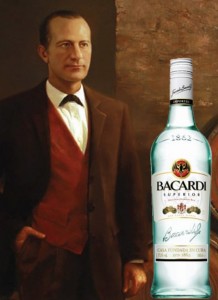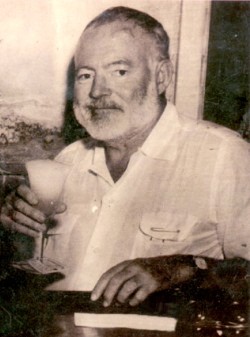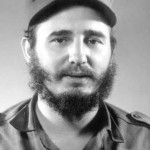Bacardi is the best-selling rum brand in the world: is achieved in 150 countries and produces 20 million dollars in profits every year.
But not a drop of liquor is sold in Cuba, where the founder of the company Facundo Bacardí opened the first distillery in 1862, in a small restaurant with aluminum roof and the dirty floor, at the slaughterhouse Street in the city of Santiago.
The story about the development of the mark is contained in the book “Bacardi and the Long Fight for Cuba” (Publisher Viking, 365 pages) of Tom Gjelten.
With a broad and rigorous report, rich details and sometimes unusual, Veteran correspondent of national public Radio tells the story of the Bacardi family, whose product helped create the Cuban spirit until Fidel Castro nationalized the company in 1960.
The Bacardi went to court to preserve its international brand and eventually managed to raise an Empire with operations in Puerto Rico, Mexico, Brazil, and the Bahamas.
“Not even think to register the Bacardi brand, so we lost”, said Castro years later. “We had the factory that produced real Bacardi rum, but could not retain its name as such.”
Facundo Bacardí was the first Cuban Mayor in the city of Santiago and was a pioneer in developing the rum of Cuban style, noted for being light, dry and smooth. He also invented a system of filter with coal and was the first to aging liquor in oak barrels.
Bacardi won international awards after 1900 and soon became the ron “made famous Cuba”.
The prohibition of the sale of alcohol in United States pushed their citizens to run Cuba, thirst for Bacardi.
An announcement of the time, features a bat – the logo of the brand, describing Gjelten as scary – loading to Uncle Sam in its talons with an empty glass from Florida to Cuba.
For the 1935 newspaper The New York Times quoted Bacardi as a proper name that entered the lexicon of United States as a generic, like term passed with Kleenex. Ernest Hemingway generally mentioned the Bacardi in his novels.
Eager to reach the American market again without having to pay taxes, the company established a distillery in Puerto Rico in 1936.
According to Gjelten, Bacardi discovered that the key to consistency in the flavor of their rum was in the cane molasses.
After overcoming problems in the distillation process, engineers managed to correct the discrepancies so that ron had a taste identical to that occurred in Cuba anywhere to do.
The Bacardi was opposed by the Cuban dictator Fulgencio Batista and Fidel Castro, supported, even allowing some of its workers to join their rebel forces.
Vilma Espin, former wife of the current Cuban President Raul Castro, was the daughter of the accounting officer of Bacardi and one of the members of the rebels under the command of Castro who fought against the Batista government.
The rebels issued a decree that would attack not Bacardi facilities, and the executive head, José “Pepín” Bosch, accompanied Castro on his first trip to United States since it took power in 1959. However, Bosch broke up because he was afraid to address that took the Castro Government.
After nationalizing Bacardi, Cuba began producing rum Havana Club, the brand the Arechabala family, producing Bacardi competitors who fought not by the name after the nationalization.
Eventually, Bacardi purchased the rights to the name of Havana Club the Arechabala family and began selling his own version of Havana Club in United States, triggering new legal battles with the Castro’s administration in Cuba.
Sources: Gjelten/AP/Internetphotos/TheCubanHistory.com
Breve Historia de la Casa Bacardi
The Cuban History
Arnoldo Varona, Editor
BREVE HISTORIA DE LA CASA BACARDI
Bacardí es la marca de ron más vendida en el mundo: se consigue en 150 países y produce 20 millones de dólares en ganancias cada año.
Pero ni una gota de licor que se vende en Cuba, donde el fundador de la empresa Facundo Bacardí abrió la primera destilería en 1862, en un pequeño restaurante con techo de aluminio y el piso sucio, en la calle matadero en la ciudad de Santiago.
La historia sobre el desarrollo de la marca está contenida en el libro “Bacardí y la larga lucha por Cuba” (Editorial Viking, 365 páginas), de Tom Gjelten.
Con un informe amplio y riguroso, detalles ricos ya veces inusuales, veterano corresponsal de la Radio Pública Nacional relata la historia de la familia Bacardí, cuyo producto ayudó a crear el espíritu cubano hasta que Fidel Castro nacionalizó la empresa en 1960.
La Bacardí fueron a los tribunales para conservar su marca internacional y eventualmente lograron levantar un imperio con operaciones en Puerto Rico, México, Brasil y las Bahamas.
“Ni siquiera pensamos en registrar la marca Bacardí, así que perdimos”, dijo Castro años después. “Teníamos la fábrica que producía ron Bacardí real, pero no pudo mantener su nombre como tal.”
Facundo Bacardí fue el primer alcalde cubano en la ciudad de Santiago y fue un pionero en el desarrollo del ron de estilo cubano, destaca por ser ligero, seco y suave. También inventó un sistema de filtro con carbón y fue el primero en añejar aguardiente en barriles de roble.
Bacardí ganó premios internacionales después de 1900 y pronto se convirtió en el ron “hizo famoso de Cuba”.
La prohibición de la venta de alcohol en los Estados Unidos empujó a sus ciudadanos a correr Cuba, sedientos de Bacardí.
Un anuncio de la época, cuenta con un murciélago – el logo de la marca, que describe como miedo Gjelten – carga al Tío Sam en sus garras con un vaso vacío de Florida a Cuba.
Para 1935 el periódico The New York Times citó a Bacardi como un nombre propio que entró en el léxico de los Estados Unidos como un término genérico, igual que pasó con Kleenex. Ernest Hemingway, en general, mencionó la Bacardí en sus novelas.
Ansioso por llegar al mercado estadounidense nuevamente sin tener que pagar impuestos, la compañía estableció una destilería en Puerto Rico en 1936.
Según Gjelten, Bacardí descubrió que la clave para la consistencia en el sabor de su ron estaba en la melaza de caña.
Después de superar los problemas en el proceso de destilación, los ingenieros lograron corregir las discrepancias para que Ron tenía un sabor idéntico al que ocurrió en Cuba en cualquier lugar para hacerlo.
La Bacardí se opusieron al dictador cubano Fulgencio Batista y Fidel Castro, apoyado, incluso teniendo en cuenta algunos de sus trabajadores a unirse a sus fuerzas rebeldes.
Los rebeldes emitieron un decreto que atacaría las instalaciones no Bacardí, y el director general, José “Pepín” Bosch, acompañó a Castro en su primer viaje a Estados Unidos desde que asumió el poder en 1959. Sin embargo, Bosch se separó porque tenía miedo de hacer frente, que tuvo el Gobierno de Castro.
Después de nacionalizar Bacardí, Cuba empezó a producir el ron Havana Club, la marca de la familia Arechabala, competidores de Bacardí, la producción que no lucharon por el nombre después de la nacionalización.
Eventualmente, Bacardí compró los derechos sobre el nombre de Havana Club a la familia Arechabala y comenzó a vender su propia versión del Havana Club en Estados Unidos, lo que provocó nuevas batallas legales con la administración de los Castro en Cuba.
Fuentes: Gjelten / AP / Internetphotos / TheCubanHistory.com
Breve Historia de la Casa Bacardí
La Historia de Cuba
Arnoldo Varona, Editor







